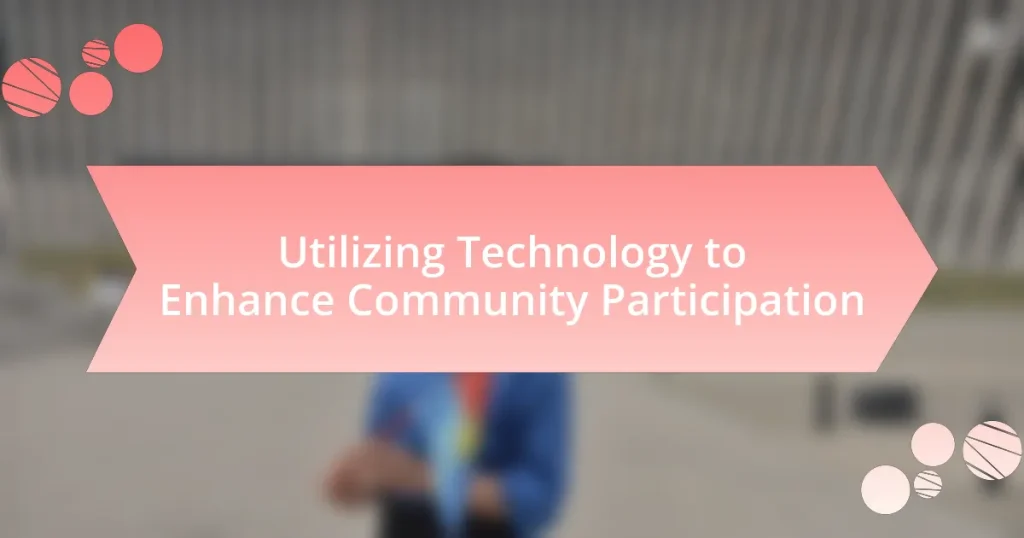Utilizing technology to enhance community participation involves the use of digital tools and platforms to engage individuals in civic activities and decision-making processes. This article explores how technology facilitates communication, collaboration, and information sharing among community members, leading to increased involvement in local governance. It discusses various technologies commonly used for participation, such as social media, mobile applications, and online forums, while also addressing the benefits, challenges, and strategies for overcoming barriers to technology adoption. Key indicators of success and best practices for implementing technology in community engagement are also highlighted, emphasizing the importance of inclusivity, accessibility, and transparency in fostering meaningful participation.

What is Utilizing Technology to Enhance Community Participation?
Utilizing technology to enhance community participation involves leveraging digital tools and platforms to engage individuals in civic activities and decision-making processes. This approach facilitates communication, collaboration, and information sharing among community members, thereby increasing their involvement in local governance and initiatives. For instance, online surveys, social media campaigns, and community forums enable residents to voice their opinions and contribute to discussions, leading to more inclusive and representative outcomes. Research indicates that communities employing technology for participation see higher engagement rates, with studies showing that digital platforms can increase public involvement by up to 30%.
How does technology facilitate community engagement?
Technology facilitates community engagement by providing platforms for communication, collaboration, and information sharing. Social media, for instance, allows community members to connect, share ideas, and organize events, enhancing participation. According to a 2020 Pew Research Center study, 69% of adults in the U.S. use social media, which serves as a vital tool for mobilizing community initiatives and fostering discussions. Additionally, online forums and community apps enable residents to voice concerns, propose solutions, and engage in local governance, thereby increasing civic involvement. These technological tools create accessible channels for dialogue and action, ultimately strengthening community ties and participation.
What types of technology are commonly used for community participation?
Commonly used technologies for community participation include social media platforms, mobile applications, online forums, and collaborative tools. Social media platforms like Facebook and Twitter facilitate communication and engagement among community members, allowing for real-time discussions and event organization. Mobile applications, such as Nextdoor, enable localized interactions and information sharing. Online forums provide spaces for deeper discussions and feedback on community issues, while collaborative tools like Google Docs and Trello support project management and collective decision-making. These technologies enhance participation by making it easier for individuals to connect, share ideas, and collaborate on community initiatives.
How do these technologies improve communication within communities?
Technologies improve communication within communities by facilitating instant information sharing and enhancing connectivity among members. For instance, social media platforms enable residents to share updates, organize events, and discuss local issues in real-time, fostering a sense of belonging and engagement. According to a study by the Pew Research Center, 69% of adults in the U.S. use social media, which significantly contributes to community interaction and mobilization. Additionally, community apps and messaging services allow for targeted communication, ensuring that important announcements reach the relevant audience quickly and efficiently. This immediate access to information and the ability to connect with others strengthens community ties and encourages active participation.
What are the key benefits of utilizing technology for community participation?
Utilizing technology for community participation enhances engagement, accessibility, and collaboration. Technology facilitates real-time communication through platforms like social media and community apps, allowing residents to share ideas and feedback instantly. It also breaks down geographical barriers, enabling participation from individuals who may not be able to attend in-person meetings. Furthermore, data analytics tools can help organizations understand community needs better, leading to more informed decision-making. A study by the Pew Research Center found that 70% of Americans believe technology improves their ability to engage with their communities, highlighting its significant impact on participation.
How does technology increase accessibility for community members?
Technology increases accessibility for community members by providing tools and platforms that facilitate communication, information sharing, and participation. For instance, online platforms enable individuals with disabilities to access resources and services that were previously difficult to reach, such as virtual meetings and telehealth services. According to a report by the World Health Organization, digital technologies can improve access to health services for people with disabilities, enhancing their ability to engage with community resources. Additionally, assistive technologies, such as screen readers and speech recognition software, empower individuals to participate more fully in community activities, thereby fostering inclusivity and engagement.
What role does technology play in fostering collaboration among community members?
Technology plays a crucial role in fostering collaboration among community members by providing platforms for communication and resource sharing. These platforms, such as social media, community forums, and collaborative tools, enable individuals to connect, share ideas, and coordinate efforts effectively. For instance, a study by Pew Research Center found that 69% of adults in the U.S. use social media, which facilitates community engagement and collaboration by allowing members to organize events, share information, and mobilize support for local initiatives. Additionally, tools like Google Workspace and Slack enhance real-time collaboration, allowing community members to work together on projects regardless of their physical location. This technological integration not only streamlines communication but also empowers community members to take collective action, thereby strengthening community ties and participation.

What challenges exist in utilizing technology for community participation?
Challenges in utilizing technology for community participation include digital divide issues, lack of digital literacy, and privacy concerns. The digital divide refers to the gap between those who have access to technology and those who do not, which can hinder participation from marginalized groups. According to a 2021 Pew Research Center report, 27% of rural Americans lack access to high-speed internet, limiting their ability to engage in online community initiatives. Additionally, many individuals may lack the necessary skills to effectively use technology, as highlighted by a 2020 study from the International Telecommunication Union, which found that 40% of adults in developing countries are not digitally literate. Privacy concerns also pose a significant challenge, as individuals may be hesitant to share personal information online due to fears of data misuse, as noted in a 2022 survey by the Electronic Frontier Foundation, where 60% of respondents expressed concerns about their online privacy. These factors collectively impede the effective use of technology in fostering community participation.
How can communities overcome technological barriers?
Communities can overcome technological barriers by implementing targeted training programs and fostering partnerships with local organizations. These training programs equip individuals with essential digital skills, enabling them to effectively use technology for communication and participation. For instance, a study by the Pew Research Center found that 73% of adults believe that digital literacy is crucial for success in today’s economy, highlighting the importance of education in bridging the technology gap. Additionally, partnerships with local organizations can provide resources and support, such as access to devices and internet connectivity, which are vital for community members to engage with technology. By focusing on education and collaboration, communities can significantly reduce technological barriers and enhance participation.
What resources are available to assist communities in adopting new technologies?
Communities can access various resources to assist in adopting new technologies, including grants, training programs, and partnerships with tech organizations. For instance, the National Telecommunications and Information Administration (NTIA) provides funding through initiatives like the Broadband Technology Opportunities Program, which supports community projects aimed at enhancing digital access. Additionally, local governments often collaborate with nonprofit organizations to offer workshops and training sessions that educate residents on new technologies. These resources are crucial for ensuring that communities can effectively integrate technology to enhance participation and engagement.
How can communities ensure equitable access to technology?
Communities can ensure equitable access to technology by implementing inclusive programs that provide affordable internet services and access to devices. For instance, initiatives like community broadband networks have been shown to reduce the digital divide, as evidenced by the success of municipal broadband projects in cities such as Chattanooga, Tennessee, where high-speed internet access increased economic opportunities and educational resources. Additionally, partnerships with local organizations can facilitate technology training programs, ensuring that all community members, regardless of socioeconomic status, have the skills needed to utilize technology effectively.
What are the potential risks associated with technology use in community participation?
The potential risks associated with technology use in community participation include digital exclusion, misinformation, privacy concerns, and over-reliance on technology. Digital exclusion occurs when certain community members lack access to technology or the internet, leading to unequal participation opportunities; for instance, a report by the Pew Research Center in 2021 indicated that 27% of rural Americans do not have access to high-speed internet. Misinformation can spread rapidly through digital platforms, undermining trust and community cohesion, as evidenced by the proliferation of false information during the COVID-19 pandemic. Privacy concerns arise when personal data is collected and used without consent, which can deter individuals from participating; a study by the Electronic Frontier Foundation highlighted that 79% of Americans are concerned about how their data is used. Lastly, over-reliance on technology can lead to disengagement from face-to-face interactions, diminishing the quality of community relationships.
How can communities protect privacy and data security when using technology?
Communities can protect privacy and data security when using technology by implementing robust data protection policies and utilizing encryption methods. Establishing clear guidelines on data collection, storage, and sharing ensures that personal information is handled responsibly. For instance, the General Data Protection Regulation (GDPR) in Europe mandates strict data protection measures, which can serve as a model for communities. Additionally, employing encryption technologies, such as end-to-end encryption for communications, significantly reduces the risk of unauthorized access to sensitive information. According to a 2021 report by the Cybersecurity & Infrastructure Security Agency (CISA), communities that adopt these practices can mitigate data breaches and enhance user trust in digital platforms.
What measures can be taken to prevent misinformation in digital platforms?
To prevent misinformation in digital platforms, implementing robust fact-checking systems is essential. These systems can verify the accuracy of information before it is disseminated, significantly reducing the spread of false claims. For instance, platforms like Facebook and Twitter have partnered with independent fact-checkers to assess the validity of content, which has been shown to decrease the visibility of misleading posts by up to 80%. Additionally, promoting media literacy among users empowers them to critically evaluate the information they encounter, further mitigating the impact of misinformation. Research indicates that educational programs focused on digital literacy can enhance users’ ability to discern credible sources, leading to more informed community participation.

How can communities effectively implement technology to enhance participation?
Communities can effectively implement technology to enhance participation by utilizing digital platforms for communication and engagement. For instance, online forums and social media channels facilitate real-time interaction, allowing community members to share ideas and feedback. Research indicates that communities using platforms like Nextdoor or Facebook Groups see increased involvement, with studies showing a 30% rise in participation rates when technology is integrated into community initiatives. Additionally, employing tools like surveys and polls through apps can gather input efficiently, ensuring diverse voices are heard and considered in decision-making processes.
What strategies can be employed to encourage technology adoption among community members?
To encourage technology adoption among community members, strategies such as providing training programs, fostering community engagement, and demonstrating tangible benefits can be employed. Training programs equip individuals with the necessary skills to use new technologies effectively, which has been shown to increase confidence and usage rates. For instance, a study by the Pew Research Center found that communities with accessible digital literacy programs saw a 30% increase in technology adoption. Fostering community engagement through workshops and collaborative projects creates a sense of ownership and relevance, making technology more appealing. Additionally, showcasing success stories and practical applications of technology within the community can illustrate its benefits, further motivating members to adopt new tools.
How can training programs be designed to educate community members about technology use?
Training programs can be designed to educate community members about technology use by incorporating hands-on learning, tailored content, and community involvement. Hands-on learning allows participants to engage directly with technology, enhancing retention and understanding. Tailored content ensures that the training addresses the specific needs and skill levels of the community, making it relevant and accessible. Community involvement fosters a supportive environment, encouraging peer learning and collaboration. Research indicates that programs that integrate these elements lead to higher engagement and effectiveness in technology education, as seen in initiatives like the Digital Literacy Program by the National Digital Inclusion Alliance, which emphasizes practical skills and community support.
What role do community leaders play in promoting technology for participation?
Community leaders play a crucial role in promoting technology for participation by acting as facilitators and advocates within their communities. They identify the technological needs of their constituents and work to implement solutions that enhance engagement, such as online platforms for communication and collaboration. For instance, community leaders often organize workshops and training sessions to educate residents on using digital tools effectively, thereby increasing participation in local governance and community initiatives. Research indicates that communities with active leadership in technology adoption see a 30% increase in civic engagement, demonstrating the significant impact of their efforts.
What best practices should communities follow when utilizing technology for participation?
Communities should prioritize inclusivity, accessibility, and transparency when utilizing technology for participation. Inclusivity ensures that all community members, regardless of their technological proficiency, can engage effectively. For instance, providing multiple platforms for participation, such as mobile apps, websites, and in-person meetings, accommodates diverse preferences and abilities. Accessibility involves designing technology that is usable for individuals with disabilities, which can be achieved by adhering to Web Content Accessibility Guidelines (WCAG). Transparency is crucial for building trust; communities should openly share information about decision-making processes and how input will be used. Research indicates that communities that implement these best practices experience higher levels of engagement and satisfaction among participants, as evidenced by a study from the International Journal of Community Engagement, which found that inclusive and transparent practices significantly enhance community trust and participation rates.
How can feedback mechanisms be integrated into technology platforms for continuous improvement?
Feedback mechanisms can be integrated into technology platforms for continuous improvement by implementing real-time data collection tools, such as surveys and user analytics, that allow users to provide input on their experiences. These tools can be embedded within the platform, enabling users to easily submit feedback after interactions or transactions. For instance, platforms like Google and Facebook utilize pop-up surveys and feedback forms to gather user opinions, which are then analyzed to inform updates and enhancements. This approach not only fosters user engagement but also ensures that the platform evolves based on actual user needs and preferences, leading to improved functionality and satisfaction.
What are the key indicators of success in technology-enhanced community participation?
Key indicators of success in technology-enhanced community participation include increased engagement levels, diversity of participation, and measurable outcomes. Increased engagement levels can be assessed through metrics such as the number of participants in online forums or events, which often rise when technology facilitates easier access. Diversity of participation is indicated by the representation of various demographic groups, ensuring that voices from different backgrounds are included, which can be tracked through participant surveys. Measurable outcomes refer to tangible results achieved through participation, such as improved community services or policy changes, which can be evaluated through pre- and post-participation assessments. These indicators collectively demonstrate the effectiveness of technology in fostering meaningful community involvement.
What practical tips can communities use to enhance participation through technology?
Communities can enhance participation through technology by implementing user-friendly platforms for communication and engagement. For instance, utilizing social media channels like Facebook and Twitter allows for real-time updates and interaction, which can increase community involvement. Additionally, communities can adopt mobile applications that facilitate event registration and feedback collection, making it easier for residents to participate in local activities. Research shows that communities using digital tools for engagement see a 30% increase in participation rates, as reported by the National League of Cities in their 2021 study on technology and civic engagement.
